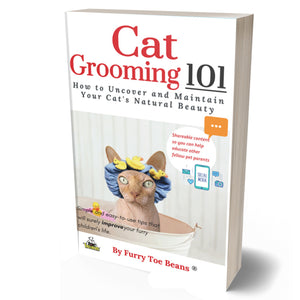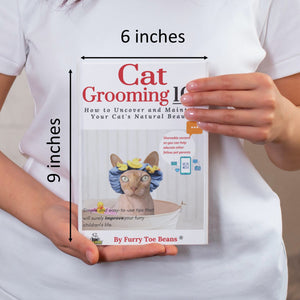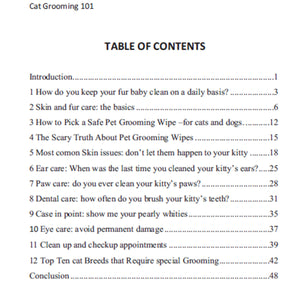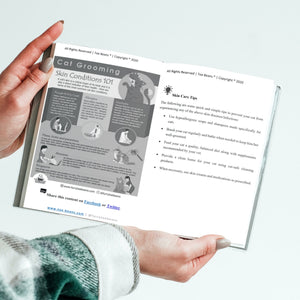Your Cart is Empty




Cat Books | Cat Grooming 101 | Paperback Format
HOW TO UNCOVER AND MAINTAIN YOUR CAT’S NATURAL BEAUTY BY TOE BEANS®
$9.50
🚚 FREE Shipping on all orders
Do you remember the last time you cleaned your cat’s ears? Or teeth? How would you rate the job? Written at an 8th-grade reading level, this 50-page must-have cat grooming guide is as educational and comprehensive as it is reader-friendly.
Written with the new cat parent in mind, this handy easy-to-read cat book contains more than 20 years of pet parenting experience and countless hours of research on cat grooming.
Scroll down to learn more about Cat Grooming 101, or check out other cat and dog 101 book titles.
Secure checkout powered by Trustedsite.
Why Cat Grooming 101?

MISSION DRIVEN
We believe that educated pet parents make better decisions for their fur children.
Bringing this book to you is an important building block of the toe beans mission to improve the life of every fur child via pet parent education.

TRIVIA NUGGETS
Did you know that cats have whiskers on the back of their front legs as well? Sprinkled throughout the book are fascinating trivia nuggets that will surprise you about your fur babies!

GREAT FAMILY READ
Sassy, entertaining, and speckled with humor this cat grooming guide makes for a great family read. Tips sections and trivia nuggets provide a framework for engaging family members in the loving care of your fur children.

GET IT FOR FREE
You can get any of the books in our pet parents’ dog and cat book series for free. Both the eBook and the paperback versions of Cat Grooming 101 are FREE with the purchase of eligible product bundles. Scroll down to the “Get it for Free” section for instructions.

BEAUTIFUL CREAM COLOR PAGES AND GRAY SCALE ILLUSTRATIONS
The paperback version comes filled with beautiful educational illustrations and pictures in gray scale. The eBook version is in full color and all the educational illustrations are one-click social media sharable.
About Cat Grooming 101
Written at an 8th-grade reading level, this 12-chapter cat grooming guide is intended to be both ridiculously simple as well as comprehensive enough to cover the basics - and a little more - about cat grooming.
From how to clean your cats' ears, to how to prepare your cat for a bath, to how to buy safe cat grooming wipes. I‘ve got you covered.
You’ll also learn about the most common skin issues and how to keep the skin and fur healthy. The book also teaches you about the importance of dental care and its impact on overall health. I share my personal experience with my kitty angel Moo and what I learned from his dental issues.
At the end of this book, we wrap everything up with a walkthrough of the 10 cat breeds that require special grooming.
Happy reading!
Who Should Read Cat Grooming 101?
Cat Grooming 101 May Be a Great Read for You If:
✔️ You are planning to becoming a new cat parent
✔️ You are a new cat mom or dad
✔️ You simply love cats
✔️ You are interested in temporary foster care for cats
✔️ You are an animal rescue volunteer
✔️ You have a young or teenage child wanting a kitty this book will be a great educational tool
✔️ You happen to find yourself in a situation where you are taking care of an orphaned kitten
Cat Grooming 101 may not be a good read for you if you’re already experienced cat parent.
The Dog & Cat Pet Parent Book Series by Toe Beans
✔️ Cat Grooming 101 is part of the Pet Parents 101 Book series, a fun, educational, and practical easy-to-read 12-book series on dog and cat care basics.
✔️ An important building block of the toe beans mission, the series is intended for every beginner pet parent, pet care giver, and cat & dog lover wishing to learn the basics or simply polish their pet care skills and improve the life of their furry child/foster/friend.
✔️ Written for all ages, every book in the series makes for a great opportunity to get the entire family involved in the loving care of furry family members.
✔️ Want it for FREE? No problem. All the books in our pet parents' dog and cat book series are free with eligible product bundles.
✔️ Fun for all ages from young children to adults.
✔️ At toe beans we believe in the power of love and joy animals bring to our lives. In return, we are devoting a lot of resources to ensure this series (still in the making) makes a small contribution to improving your furry children/friends' lives.
In Paperback and eBook Versions
✔️ Cat Grooming 101 is conveniently available in paperback and eBook.
✔️ Both versions are FREE with the purchase of eligible product bundles.
✔️ Whether you're an old-school book reader or prefer to read on your computer, tablet, or phone, we’ve got you covered.
✔️ Check out the advantages and disadvantages of each format in the chart.
✔️ A cool feature of the paperback option is that they can be autographed upon request and at no cost.
✔️ A short 100 words can also be handwritten. This unique feature makes for a great gift for somebody that has made the wonderful decision to become a dog parent for the first time.
Want Cat Grooming 101 for Free?
How to get the eBook version for FREE:
✔️ Purchase our Organic Bliss bundle:
- USDA certified organic 2-pack catnip
- USA-made, BPA free dog & cat wet food saving can lids
- Cat Grooming 101 eBook
(Save time - click here to automatically add all 3 items to your cart.)
✔️ Hit checkout then enter coupon code: CGE to make the eBook FREE.
Rather get the paperback version instead?
✔️ Purchase our Organic Bliss PLUS bundle:
- USDA certified organic 2-pack catnip
- USA-made, BPA free dog & cat wet food saving can lids
- Your choice of Momma KNows Best USDA organic moisturizing balm
- Cat Grooming 101 - paperback
(Save time - click here to automatically add all 4 items to your cart.)
✔️ Hit checkout then enter coupon code: CGP to make the eBook FREE.
About the Author
K. Marie Alto is a fur mom, wife, wannabe writer, blogger, and the co-founder and Chief Fur Children Happiness Officer at toe beans.
With over 20 years of experience as a pet momma, K. Marie loves sharing her personal journey and experience as a pet parent via her blog and Facebook page where she currently has more than 30K followers (@furrytoebeans) and counting.
Driven by her mission to improve the lives of every fur child, K. Marie dreams of a world with happier, more active, healthier, and longer living fur children in every home.
She believes that safety of pet products should be every pet parent’s #1 priority. Purchasing products that are truly safe for dogs and cats can be a challenge in the wild west of the pet products industry. That’s why she is committed to educating pet parents to make smart purchasing decisions on behalf of their beloved fur children.
Toe Beans is a US based ecommerce direct to consumer pet products online boutique.
PET PARENT EDUCATION
Cat Grooming FAQs
-
The frequency of grooming your cat at home depends on their breed, coat length, and individual needs. Cats with longer hair may require more frequent grooming sessions, while medium-haired cats can benefit from weekly sessions. Regular grooming helps prevent matting, reduces shedding, and promotes a healthy coat. Assess your cat's coat and adjust the frequency accordingly.
-
You'll need a few essential tools including a soft-bristle brush or comb suitable for your cat's coat type, a cat-specific nail trimmer, cat-friendly shampoo (if bathing is necessary), ear cleaning solution, toothbrush and toothpaste formulated for cats, and gentle wipes for cleaning the eyes. Having these tools readily available will make your grooming sessions go smoother.
-
Introducing your cat to grooming should be done gradually and with patience. Start by getting your cat accustomed to being touched and handled in the areas you'll be grooming. Offer treats and praise during these sessions to create positive associations. Gradually introduce grooming tools, allowing your cat to sniff and investigate them. Go at your cat's pace and make the experience as enjoyable as possible.
-
Brushing your cat's fur is an important part of grooming. Use a brush suitable for your cat's coat type and brush in the direction of hair growth. Be gentle and avoid pulling or tugging on any tangles. Pay attention to areas prone to matting, such as the belly and armpits. Regular brushing not only helps keep your cat's coat healthy but also strengthens the bond between you and your feline friend.
-
While most cats are proficient self-groomers and don't require frequent baths, there are situations where bathing may be necessary. Use a cat-specific shampoo and warm water. Place a rubber mat or towel at the bottom of the sink or tub to provide traction. Wet your cat's fur thoroughly, apply a small amount of shampoo, and gently massage it into the coat. Rinse thoroughly, ensuring no residue remains. Towel dry or use a low-heat blow dryer on the lowest setting if your cat tolerates it.
-
Trimming your cat's nails is an essential part of DIY grooming. Start by getting your cat used to having their paws handled. Choose a quiet, comfortable area for the nail trimming session. Use a cat-specific nail trimmer with sharp blades. Gently press each paw's pad to extend the claws and carefully trim the sharp tips, avoiding the quick (the pink area inside the nail). If your cat becomes too stressed or anxious, take breaks and resume later. Reward your cat with treats and praise after each successful trimming session.
-
Cleaning your cat's ears helps prevent wax buildup and infections. While this is uncommon in younger cats, it may be necessary to help your aging kitty. Use a cat-specific ear cleaning solution and cotton balls or pads. Gently lift your cat's ear flap and apply a few drops of the solution. Massage the base of the ear to distribute the solution, then allow your cat to shake their head. Use a cotton ball to wipe away any visible dirt or debris from the outer ear. Avoid inserting anything deep into the ear canal. If you notice redness, swelling, or an unpleasant odor, consult your veterinarian.
-
Brushing your cat's teeth is crucial for their oral health. Start by introducing your cat to the taste of cat-friendly toothpaste and allow them to lick it off your finger. Gradually transition to using a cat-specific toothbrush. Gently lift your cat's lips and brush their teeth using gentle, circular motions. Start with short sessions and gradually increase the duration over time. Reward your cat with praise and treats for positive reinforcement. Regular toothbrushing can help prevent dental issues and promote overall wellness.
-
Cleaning the area below and around your cat's eyes helps remove any debris or discharge. Moisten a soft, clean cloth or cotton ball with warm water and gently wipe away any crust or discharge from the corners of your cat's eyes. Use a separate cloth or cotton ball for each eye. Be careful not to touch the eyeball itself. If you notice persistent or excessive eye discharge, redness, or swelling, consult your veterinarian.
-
Senior cats may require some adjustments to their grooming routine. They may have reduced mobility, arthritis, or sensitive skin, so take extra care when handling and grooming them. Use grooming tools specifically designed for seniors, such as brushes with softer bristles. Monitor their comfort levels during grooming and be mindful of any signs of discomfort or stress. Consulting with your veterinarian can help tailor the grooming routine to your senior cat's individual needs.
-
Shedding seasons, which typically occur during spring and fall, require extra attention to keep your home and cat's coat clean. Increase the frequency of brushing sessions during these times to help remove loose hair. Consider using grooming tools specifically designed to address shedding, such as de-shedding combs or brushes. Ensure your cat has a healthy diet, rich in Omega-3 fatty acids, which can promote a healthy coat and minimize shedding.
-
Mats in your cat's fur can be uncomfortable and may require careful handling. Use a mat splitter, mat rake, or blunt-end scissors to carefully work through the mat, starting from the edges and working your way inward. Take your time and be cautious not to pull or hurt your cat's skin. If the mat is too severe or your cat becomes too stressed, consider seeking professional help from a groomer or veterinarian.
-
Whiskers are essential sensory organs for cats, and they should not be trimmed or groomed. Whiskers provide valuable information about a cat's environment, helping them navigate and maintain balance. Trimming or grooming whiskers can cause disorientation and stress for your cat. Respect your cat's whiskers and avoid any grooming practices that may interfere with their natural function.
-
Creating a positive and enjoyable grooming experience for your cat is essential. Use treats, praise, and rewards throughout the grooming session to reinforce positive behavior. Keep the environment calm and quiet, minimizing distractions. Take breaks if your cat becomes overwhelmed or stressed. Find grooming tools that your cat is comfortable with and associate them with positive experiences. The more you can make grooming a positive and pleasant activity, the easier it will be for both you and your cat.
-
Cats with sensitive skin require extra care during grooming. Use gentle grooming tools and products specifically formulated for sensitive skin. Avoid vigorous brushing or harsh scrubbing during baths. Opt for hypoallergenic shampoos and avoid any products that may irritate your cat's skin. If you notice signs of irritation, redness, or excessive scratching, consult your veterinarian for guidance on suitable grooming techniques and products for your cat's sensitive skin.
-
Hairballs can be a common issue for cats, but there are ways to help prevent them. Regular grooming, particularly brushing, helps remove loose hair and reduces the amount your cat ingests during self-grooming. Consider adding hairball control supplements or specialized cat food to their diet, as these can help reduce the formation of hairballs. Consult with your veterinarian for recommendations specific to your cat's needs.
-
If your cat has fleas or ticks, grooming alone may not be sufficient to address the problem. It's essential to consult your veterinarian for appropriate flea and tick treatment. Your veterinarian can recommend safe and effective products to eliminate the parasites. Grooming can complement the treatment by removing dead fleas or ticks from your cat's coat. Ensure you follow your veterinarian's guidance to effectively address the infestation.
-
Grooming a pregnant cat requires extra caution and gentle handling. Avoid any unnecessary stress or pressure on the abdomen. Focus on gentle brushing and keeping the coat clean. If you have concerns or are unsure about grooming your pregnant cat, consult your veterinarian for guidance on safe grooming practices during pregnancy.
-
If your cat becomes aggressive or overly stressed during grooming, it's important to prioritize their safety and well-being. Stop the grooming session immediately and allow your cat to calm down. Assess if there is any specific trigger causing the aggression, such as pain or discomfort. If aggression persists or you're unable to groom your cat safely, consult a professional groomer or a veterinarian who can provide guidance or recommend behavioral interventions.
-
Professional grooming services can be beneficial for various reasons. Consider seeking professional help if you are uncertain about handling certain grooming tasks, such as severe matting or nail trimming. Additionally, if your cat has specific grooming requirements due to their breed or medical conditions, a professional groomer can provide specialized care. Assess your comfort level, your cat's individual needs, and consult your veterinarian for guidance on whether professional grooming services are necessary in your particular situation.











